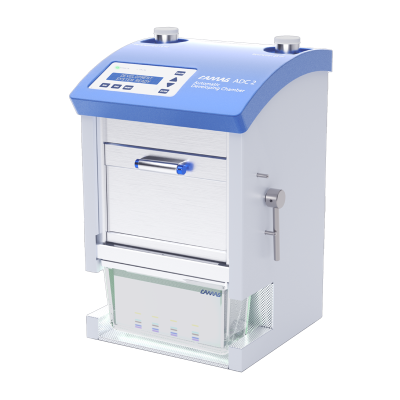HPTLC PRO
Module DEVELOPMENT
CAMAG® HPTLC PRO
Module DEVELOPMENT

In a nutshell
Full Automation for Reproducible and Efficient development
The advanced developing chamber of the HPTLC PRO Module DEVELOPMENT revolutionizes chromatography by fully controlling the gas phase, ensuring highly reproducible results, and significantly reducing pre-conditioning and activation time.
-
5HPTLC glass plates
-
3different developing solvents
Controlled by visionCATS HPTLC Software, the Module DEVELOPMENT autonomously develops up to five HPTLC glass plates (20 × 10 cm) sequentially, using up to three different developing solvents.
-
Part of the fully automated HPTLC PRO SYSTEM
-
Development of up to 5 HPTLC plates (20 x 10 cm)
-
Supports up to 3 different developing solvents
-
HPTLC glass plates (20 x 10 cm)
-
Software-controlled by visionCATS
Stand-alone operation
With HPTLC PRO, users have the choice to either operate a module as stand-alone or together with other modules in a SYSTEM MODE.

SYSTEM MODE
If two or more modules are connected to form a system, a conveyor moves the HPTLC plate from one Module to the other, eliminating manual intervention between individual process steps.
SMOOTH & PRECISE OPERATION

01
After application of all samples, the plate is moved to the Module DEVELOPMENT.

02
The plate containing the samples applied is ready to be loaded into the developing chamber.

03
The tilting mechanism moves the plate from a horizontal to a vertical position into the developing chamber, where it is then developed according to the selected method.

04
After development and drying in the chamber, the plate is returned to a horizontal position, ready to be transferred from the Module DEVELOPMENT to other modules for further processing.
KEY benefits
Technical specifications
-
Classification of installation and useClass I, installation category II, protection class IPX0, Pollution degree 1
-
Nitrogen or clean air pressure5 – 8 bar (70 – 110 psi)
-
Operating temperature15 – 30 °C
-
Recommended working temperature20 – 25 °C
-
HumidityMaximum relative humidity 80 % for temperatures up to 30 °C (Humidity and temperature conditions must not cause condensation!)
-
Plate typesHPTLC glass plates 20 x 10 cm, layer thickness 200 µm
-
Operating voltage100 – 240 VAC; 50 / 60 Hz Fluctuations ±10 % of the nominal voltage Overvoltage category II
-
Power consumption40 W
-
Fuses2.0 AT, 250 VAC
-
Max. supply current from power outlet8 A
-
Dimensions (W x D x H):384 x 550 x 510 mm
-
Weight~ 41 kg
What you need to get started
Ordering Information
-
060.3000
CAMAG® HPTLC PRO Module DEVELOPMENT
Can be operated either as stand-alone or as part of the fully automated CAMAG® HPTLC PRO SYSTEM. Allows to autonomously develop up to five different HPTLC glass plates with up to three different developing solvents. The gas phase can be actively circulated. Includes 2 Carriers for HPTLC glass plates (20 × 10 cm), and a set of bottles for start-up.
Interested in the product?
Reach out to your local distributor and enjoy faster, improved results at reduced costs.








